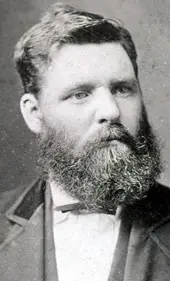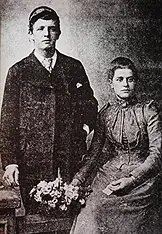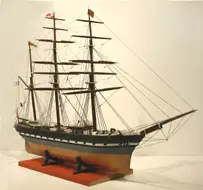2. Early Life
Of the ten children of William Murdoch's great grandparents Samuel Lowden Murdoch, a shoemaker, and Jane Young, a sister in law of John Paul Jones, five of seven sons would become masters in sail; their sons and nephews would go to sea in due turn, generation after generation, commanders of their own vessels and those of their extended kin. By close of the 19th Century, the Murdochs were related by blood and marriage to some of the prominent sailing ship owners and master mariners of Britain, had contributed a Resident Commissioner to the Colonial Office, and their own history had become entangled with that of the country. All through the life of the Second British Empire, the Murdochs and their brother officers of the merchant marine diligently conveyed its commerce and its peoples, and if required its troops, from port to ever more exotic port, in the old mercantile tradition, "by the Grace of God in good order".

William's father Captain Samuel
Murdoch. Courtesy of Wendy
Murdoch Roberts.
(Click to enlarge)
It was a family heritage that came at a terrible price. Each generation, there were some who died at sea from the hazards and horrors endemic to the age and their profession. Not a few met a more sinister fate: Overdue, presumed lost. In April of 1901, William Murdoch's cousin Captain John Murdoch, en route from New Caledonia to Philadelphia in command of J & J Rae's Craignair, vanished, and with him his new wife: Murdoch women (and sometimes children) went to sea, too. In April of 1906, his uncle, another William Murdoch and already in retirement, acceded to the owner's request that he assist the master commanding the schooner Mary, and perished when she was driven on Rascarrel Rocks at Auchencairn Bay. Another Captain John Murdoch, a sole surviving paternal uncle, died at sea in April of 1907, while first officer of the Anglo American Oil Company's Alcides, and in that same year Captain James T. Thorburn, husband of one of William's aunts, was lost along with his 15 year old son and twelve of his crew when the barque Dundonald was wrecked in the Auckland Island group off New Zealand. (This last disaster was commemorated in the book The Castaways of Disappointment Island.)
Death on the sea was the omnipresent quid pro quo for the putative glamour of life as a deck officer. It was a knowledge that William Murdoch could appreciate from personal experience; he was already an officer with the White Star Line when his uncles and cousins died. The long family tradition of merchant marine service had its benefits: it enabled the family to live comfortably and with the advantages that middle class rank bestowed in Victorian England. William Murdoch's father, Captain Samuel Murdoch, was one of the best known captains in San Francisco, in its raffish youth when the Barbary Coast was not yet semi respectable and Nob Hill was even more exclusive. The home he built in Dalbeattie for his wife, Jeannie Muirhead of Palnackie, and their six surviving children he named "Oakland", after San Francisco's siser port across the Bay in Alameda County. As were all the family's homes, "Oakland" was filled with model sailing ships and with pictures and photographs of the owner's successive commands. Captain Samuel Murdoch, whose personal friends included Joseph Conrad, sailed around the Horn to the West Coast of South America and to California, among other places, and, following another family practice, his son William sailed as one of his officers.

Young Murdoch with
his sister Agnes.
(Click to enlarge)
Despite long separations, the family was affectionate, and those who preferred to stay in Scotland had considerable parental money available for education. William's older brother James, who also died at age 39, in 1906, became a chemist; the youngest son, Samuel, was a merchant with Lockett Brothers in the nitrate mines of Iquique in South America. William's sister, Margaret Elizabeth (the "Peg" of his April 8, 1912, letter from the Titanic) earned a Master's Degree at Edinburgh University, in the day when higher education for women was still considered rather radical. A headmistress for many years, Margaret was a woman of generosity and humor, upright, strict and principled as the Victorians embodied those virtues, and very kind. She had been born in 1882, and despite the nine years difference in age was William's friend and confidant as well as younger sister. Like most of the family who did not die at sea, she lived to a great age, and died in 1973, at 91.
The family attachment can be seen in its final symbol. At the Dalbeattie cemetery, Samuel Murdoch selected a single tombstone for his wife and the three children who predeceased him. He himself and two more daughters would ultimately lie beneath the marker, and, perhaps uniquely, his mother in law is there, too.
William Murdoch, the middle son, as a boy built model ships, and demonstrated an enthusiasm for the sea sufficiently well known to appear in the Kirkcudbrightshire Advertizer on April 26, 1912. He attended the old Dalbeattie High School (now the junior school) and graduated circa 1887, leaving behind a reputation for intelligence and application that culminated in 1912 in the Murdoch Memorial Prize for academic excellence that his fellow townsmen considered the most appropriate way to honor his memory. Unlike his two brothers, it is unlikely William even considered a land based profession. The moment he obtained his diploma, he went to sea, apprenticed to the Liverpool firm of A. Rae (afterwards J. and J. Rae & Company); the Raes were relations and the Murdochs regularly served in their ships. The firm's founder, Captain Alexander Rae, was Captain Samuel Murdoch's uncle, and still living when William commenced his career in the 1,000 ton barque Saint Cuthbert.
The Saint Cuthbert was a mere 211 feet by 33.7 feet, and traded to the West Coast of South America, a voyage that meant months of cramped, uncomfortable life with stringent rations, ferocious discipline and the very real probability of appalling weather around Cape Horn at any time of year. These were the last years of "wooden ships and iron men", and to those officers who lived through them the brave new world of clean linen, fine china and the British breakfast, all available at 21 knots, being created by the steamship lines must have seemed magical.

William and his uncle both built models
of the elegant little Loch Urr
(Future Museum, South West Scotland)
The Saint Cuthbert would sink during a hurricane off the coast of Uruguay in 1897, but by then Murdoch was no longer of her company; he had obtained his professional certificates with alacrity, and served as a mate on at least one of his father's ships. He is believed to have sailed with his uncle, Captain John Murdoch of Kippford, on the Loch Urr, which his father had commanded from 1873 to 1880; Loch Urr was a 731 ton steel barque built in 1870 in Port Glasgow for J. Sproat & Co. of Liverpool, which vanished with all hands off Cape Horn in 1891 or 1892, after she had passed to a new master. A model of her still exists, safe inside a glass case. William and his uncle both built models of the elegant little Loch Urr, but the one on display in Stranraer is William's creation.
Although still quite young, Murdoch served as First Officer on the 1,941 ton Iquique, after mid summer of 1893; Captain Samuel Murdoch had taken Iquique on her maiden voyage, in August of 1892, from Glasgow to Rio and Taltal, ending in Rotterdam in July of 1893. William was definitely no longer on Iquique by June 11, 1896, as his cousin John Murdoch, who would ultimately perish in the Craignair, was serving as First Officer then. The Lydgate, a four masted steel barque of 2,534 tons built in 1893 for Liverpool's J. Joyce & Company, was another of William's ships in the 1890s, and possibly also the Solway, a 1,720 ton steel barque built in Glasgow in 1895 for Rae. There may have been others.
Lloyd's Captains' Registers, Vol. 67, Record of Service 1896 1903, records for William McMaster Murdoch: Passed Liverpool, 1896, Certificate No. 025780, special qualifications and steam. Murdoch was just 23 when he was granted his Master's Certificate; an Extra Master's Certificate would later be added, a fact inexplicably not noted by some Titanic writers. Sometime prior to the turn of the Century, he was hired by the White Star Line, and first appears in Lloyd's Captains' Register assigned to the Runic, bound for Australia via the Cape of Good Hope, June 13, 1901.
